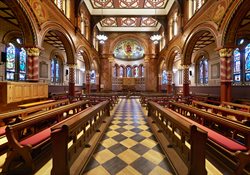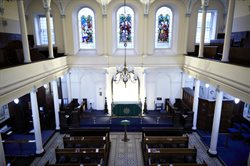Chapels
The College Chapel
 The College Chapel at the Strand is seen by many as the spiritual heart of the College.
The College Chapel at the Strand is seen by many as the spiritual heart of the College.
The Chapel is a focus for Christian worship at the Strand as well as a place of peace in our busy College.
The Chapel is located on Level 2 of the King's building directly above the Great Hall and is a remarkable piece of Victorian architecture.
The following documents containing information on the College Chapel's history are available to download:
The definitive history of the College Chapel written by Gordon Huelin FKC
A Brief History of King’s College Chapel at the Strand
Chapel of Thomas Guy
 The 18th-century Chapel of Thomas Guy is opposite Boland House and is open to all members of King’s. Visitors are welcome to use the space to pray, rest, reflect or light a candle. The Chapel is home to a commissioned icon of Jesus and Mary, which can be found on the organ side of the Chapel. As the historic Chapel of Guy's Hospital, it houses the tomb of Thomas Guy (which can be seen by arrangement with the Chaplain) as well as the tomb of Astley Paston Cooper, the 19th-century surgeon and scientist.
The 18th-century Chapel of Thomas Guy is opposite Boland House and is open to all members of King’s. Visitors are welcome to use the space to pray, rest, reflect or light a candle. The Chapel is home to a commissioned icon of Jesus and Mary, which can be found on the organ side of the Chapel. As the historic Chapel of Guy's Hospital, it houses the tomb of Thomas Guy (which can be seen by arrangement with the Chaplain) as well as the tomb of Astley Paston Cooper, the 19th-century surgeon and scientist.
Who was Thomas Guy?
Thomas Guy (1644 – 1724), founded Guy’s Hospital. He made his fortune as a bookseller and also invested in the South Sea Company, a company linked to the trans-Atlantic slave trade.
Guy was a governor of St Thomas' Hospital, then located on the London Bridge side of St Thomas' Street. He decided, in 1721, to found a new hospital from which no one would ever be turned away for financial reasons. He died soon after dedicating his money to this cause.
The Colonnade of the original hospital, which still stands today, was built first with the two little courtyards on either side of it. The front courtyard was completed in 1780.
Why does it matter?
This part of London has been the focus of medical endeavour since the monks at what is now Southwark Cathedral began to care for the sick in the twelfth century. Their hospice later became St Thomas' Hospital, with Guy's Hospital itself developing in the 18th-century.